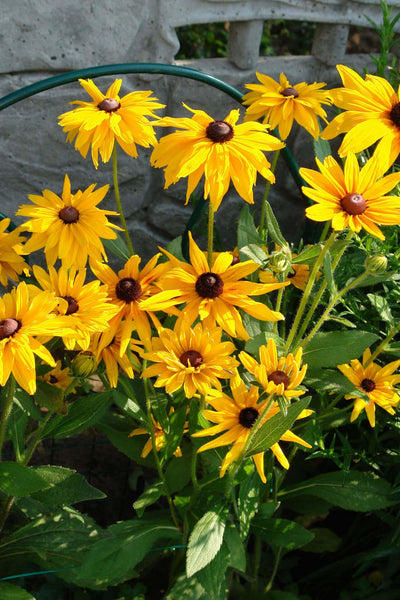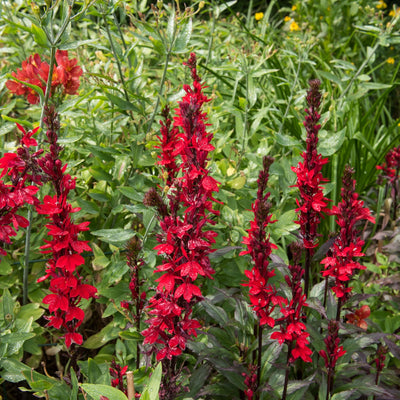What does perennial mean? Here are 12 frequently asked gardening questions answered.
What does annual mean? What does perennial mean? What plants can I grow in rocky soil? We hope to answer all of those questions and more in this article. And if you have any questions that we haven’t answered, please reach out to us. We love sharing what we know with others.What does perennial mean?
The word perennial means a plant that the plant will grow, flower, seed, and return year after year.
Buying perennial means that you're getting low-maintenance plants that will return the following year. Plus, it's super cost effective!
Where can I buy perennial plants?
There is a wide range of sellers you can buy from. Here at Tennessee Nursery, we mostly sell perennial plants and bare-root plants.
We know how important pollinators are for our gardens and our world. That’s why we specialize in hardy native perennials which means they will adapt to your environment more easily. Most of our plants (94% in fact) are native to the US.
We strive to give our customers plants that they will love-- that’s why we have so many repeat customers!
Check out our stock, we hope you’ll find a plant (or two) that you like. Some of our plants sell out, so place your orders early to ensure they will arrive to you this season!
How long do perennial plants live?
Perennial means that a plant will return in subsequent years. The shortest-lived perennials live at least three years. However, many will live longer than that.
The longest-lived perennials can live hundreds of years! In fact, there are plenty of old plants still around today.
In the Chinese city of Taiyuan, there are tree peonies that are over 400 years old! If you thought that was impressive, there are perennials that are older than that.
In the town of Hildesheim, Germany there is a rose that is more than 700 years old! Imagine a plant that was around when your earlier ancestors were born. With the right care, some perennials can live for centuries.
What does annual mean?
Because perennial means that the plant will return yearly, annual indicates that the plant will live only a year. Annuals will grow, flower, seed, and die off in a single year.
There is a chance of the plant returning in subsequent years if its seeds have sprouted and taken root. Many annuals are killed by frost in colder climates. Some plants are not adapted to frosty weather conditions.
To ensure your annual return, you have several options:
- Let the seeds fall to the ground, with luck they will grow into plants next year
- Collect the seeds yourself and start them indoors in early spring or outdoors once there is no longer a risk of frost.
- Buy new annuals or replace them with long-lived perennials.
When can I begin planting?
When you begin planting depends on what USDA zone you live in. In all climates, it is best to begin planting after all danger of frost has gone.
But remember, perennial means that a plant is frost-hardy, so it may tolerate being planted in slightly frosty conditions.
Frost will kill tender plants, especially delicate seedlings. Pay attention to the weather changes and keep a garden journal if you can. That way you can keep track of weather changes throughout the year and how those changes impact your plants.
How do I know what zones I live in?
A USDA zone is an indication of weather patterns and average temperature highs and lows in an area. This is liable to change (and has) with the changing climate.
At TN Nursery, we have a tool that will tell you your USDA zone. Just type in your ZIP code and we will let you know your zone.
Colder zones are lower numbers while warmer zones are higher numbers. The US has land in zones 1 in the north of Alaska to 13 in the south of Florida.
Each state may have a range of zones. Even at the county level, there may be differing zones in different parts of the county.
How do I know what kind of soil I have?
This is one of the most important questions a gardener can ask!
Knowing what kind of soil you have is extremely helpful when selecting plants. The pH (parts hydrogen) scale ranges from extremely acidic 0 to extremely alkaline 14. The ideal soil range is 6.2 to 6.8.
Clay soils tend to lean more alkaline. Sandy soils tend to be more acidic. This is not always the case, so we recommend you do a soil test.
Most nurseries have basic soil tests available. You can also buy them online– make sure the source is reputable to ensure an accurate test result.
The most accurate soil tests are available at Extension Offices that are part of a University. Most tests cost around $10.
These tests will tell you your soil's pH and nutrient levels. They even have fertilizer ratio recommendations. All you have to do is collect some garden soil and send it to the research lab on a prefilled envelope that comes with the test. You should receive your test results in a few weeks.
How can I create a low-maintenance garden?
All gardens need some maintenance, but that doesn’t mean you can’t have a low-maintenance garden. Because having a perennial means they will return yearly, perennials make excellent low-maintenance options.
Here are some things to consider when selecting low-maintenance plants
- How much does this plant spread?
- Will I have to divide the plant in flowering years?
- Do I have to deadhead the flowers or will they continue to bloom without interference?
- How much ground do I have to cover?
- Do I have any helpers that could assist me in garden maintenance?
With low-maintenance gardening, less is more. We recommend selecting several plants and using them repeatedly throughout your garden. Fewer plants usually mean less work!
Are there any perennial plants I can grow in sandy soil?
Yes! Sandy soil may be tricky to plant in, but it has the benefit of draining water easily. You can always amend your soil with compost or mulch to make improve the structure.
Here are a few sand-tolerant plants:
Bearded Iris
Are there any perennial plants I can grow in clay soil?
Yes, again! While clay can be a major pain, there are plants that do well growing in it. Once again, you can always amend your soil. This may take a few years, but it will allow you to grow a greater variety of plants.
Here are a few clay-tolerant plants:
Daylily
Yarrow
Are there any perennial plants I can grow in wet soil?
Once again, yes! There are plants that can tolerate high levels of moisture. Wet soil is the most difficult soil to grow in, but don't let that deter you.
Here are a few moisture-loving plants:
Siberian Iris
Red Hibiscus
Are there any perennial plants I can grow in rocky soil?
Here are a few plants that will thrive in rocky gardens:
Milkweed
Shasta daisy
We hope this list answered some of your garden questions. Whether you are a customer or not, feel free to reach out to us! We love sharing our gardening knowledge with anyone who is interested.


